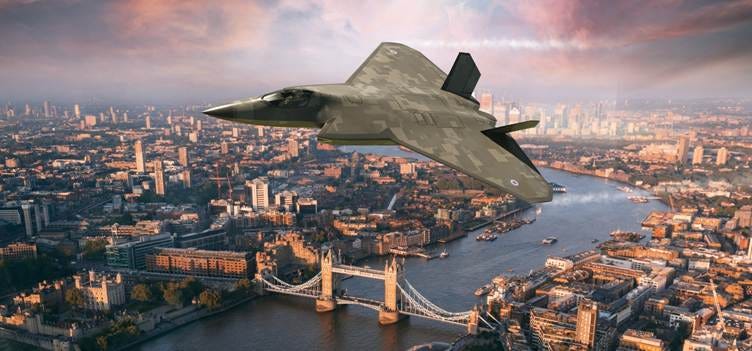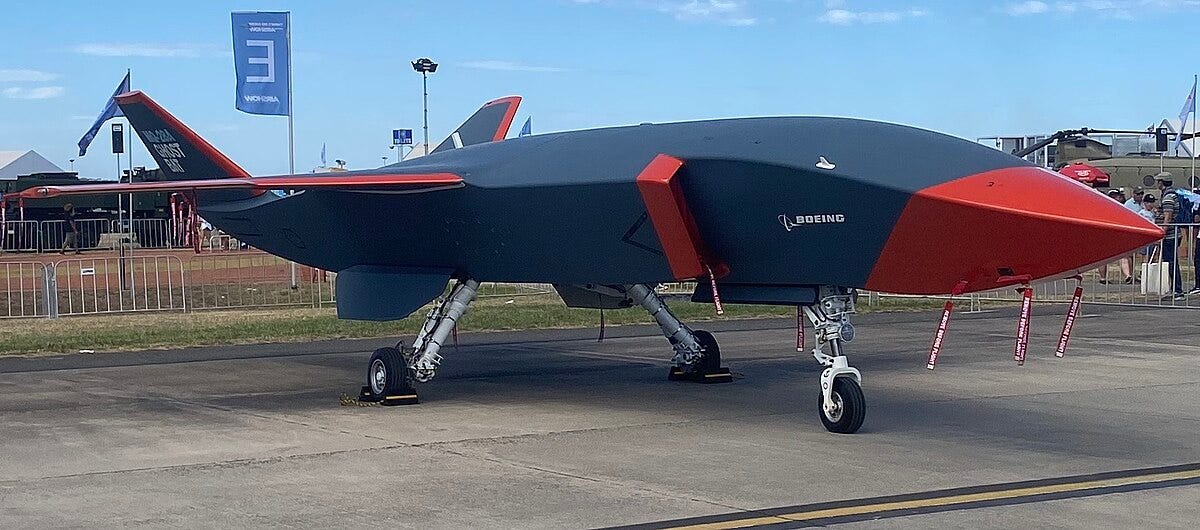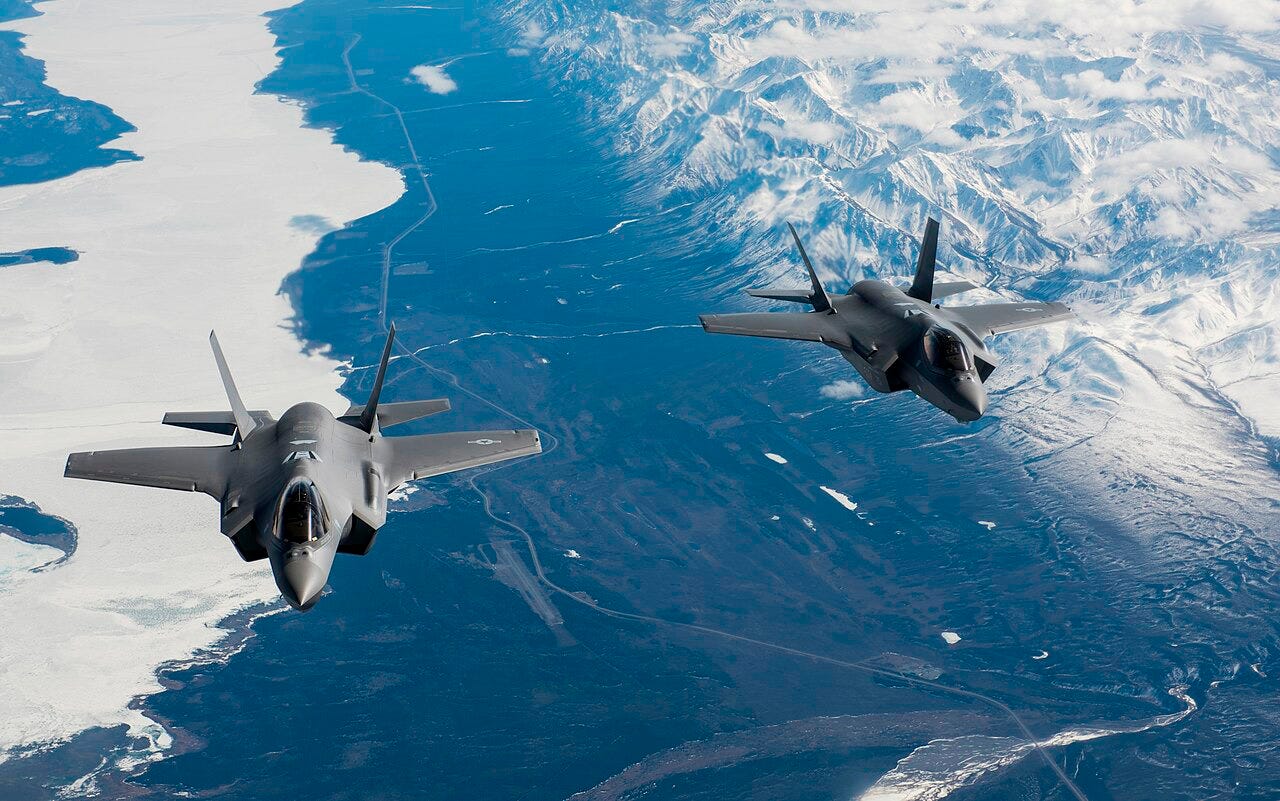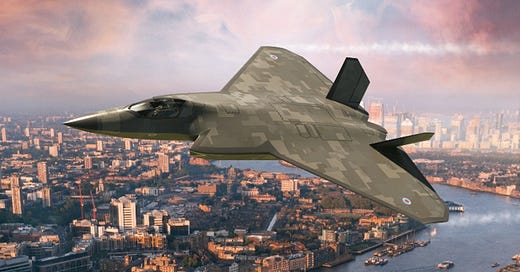After much feverish speculation from British defence-watchers, the Prime Minister last year confirmed that the UK is going ahead with the Global Combat Air Programme (GCAP) alongside Italy and Japan. Assuming that there isn’t another U-turn in the Strategic Defence Review and noting that the UK is going to be spending a lot of money on GCAP, it is worth going over this project in some detail.

What is GCAP and why is it not FCAS?
GCAP is a hefty endeavour ultimately aiming to develop and produce a new manned ‘sixth generation’ fighter jet.1 In collaboration with Japan and Italy, the ambitious aim is to have the aircraft in service by 2035, to replace the UK’s current fleet of Eurofighter Typhoons.
The Global Combat Air Programme started life as a British project in the mid-2010s to design a system for future air combat – known imaginatively as the ‘Future Combat Air System’, or FCAS – based around ‘Tempest’, a new crewed fighter jet. By the 2020s, the UK looked around for potential international partners, which, through a variety of agreements, led to the Global Combat Air Programme being formally and announced and then ratified in late 2022 by Britain, Italy and Japan.
It should be noted that FCAS and Tempest have not gone away. FCAS is a large project aimed at providing a whole system of different equipment for future air combat – weapons, drones, sensors, etc – which includes the manned fighter being delivered by GCAP, which under British service will be called Tempest.
As of writing, the three partners are the UK, Italy, and Japan; there is continual speculation that Saudi Arabia may join, but this has not – yet! – come to pass.
Why GCAP?
The ultimate aim of GCAP is to have a sovereign, next-generation fighter jet that is able to overmatch adversaries (i.e., Russia and China). Its prime aim is ‘air dominance’ – i.e., gaining complete control of the air to the point that the enemy cannot operate freely within it – which includes the ability to destroy other aircraft and deny air defence, whether through ‘kinetic’ (explosive boom) or ‘non-kinetic’ (electronic wizardry) means, or by enabling other assets (such as drones) to do it instead.
All very well and good. But why would the UK go through the effort and cost of designing and building our own plane (along with the Italians and Japanese) when we could potentially buy a similar system in the future from someone else?
There are two answers to this. The first is that it keeps the wheels of the UK’s defence and aerospace industry churning – jobs, skills, knowledge, output. Frankly, if GCAP isn’t built, then all three nations have to accept that they are no longer in the high-end fighter design business. The skills, research, manufacturing capacity will essentially be lost and will be almost impossible to regenerate. This obviously would have a major economic impact as well: a PwC report – albeit one commissioned by the prime contractor BAE systems – suggested that GCAP could contribute £37bn to the UK economy over its lifespan.
The second answer is that if you design and build a sovereign plane, you own the rights to it. You can change it, modify it, and (importantly!) sell it. This is not something you can do if you use another nation’s equipment. For instance, the USA is infamous for controlling defence exports through International Traffic in Arms Regulations (ITAR), which is one of the reasons why countries that have wanted to gift certain forms of weaponry to Ukraine have been unable to do so due to US restrictions on American-made components.2
In today’s brave new world of geopolitics, this is a particularly pressing concern considering the USA’s uncertain future with NATO.3 There has been a lot of consternation in recent weeks over European air force’s hefty reliance on US support for the upkeep of their F-35s, which require continual maintenance and regular software updates directed from the United States. While talk of a ‘kill switch’ might be overblown, if the US decided to play hardball it could seriously disrupt European air power and the F-35 in particular. Designing, building, and flying your own warplane negates this massive risk of being reliant on an uncertain ally.
What about Drones?

It should be emphasised that GCAP as a programme is focused only on creating a crewed fighter jet, which has proven a little controversial. It is still a matter of debate as to the extent to which crewed aircraft will still be critical in aerial warfare; I don’t pretend to be a supreme expert on the subject, but most commentators believe that manned aircraft will still be required for the foreseeable future. However, the issue is less that they will, but whether it is worth three smaller nations going through the cost and effort of developing a whole new crewed aircraft system rather than focusing on high-tech uncrewed drones.4
From a UK perspective, the production of high-tech autonomous ‘wingmen’ drones should be covered under FCAS. However, noting that the general trend in western military futurism is strongly heading towards manned/unmanned teaming (i.e. humans operating alongside robotic teammates), and that all three partner nations will probably want to have ‘wingmen’ at some point, I would not be surprised if developing autonomous drones to fight alongside the manned aircraft will become a subsidiary task of GCAP – if you are cooperating on the plane, why not on the drones too?
SCAF – the other FCAS
Major defence programmes – especially warplane programmes – are absurdly expensive, and it usually makes sense for countries to pool their resources to fund such projects. GCAP would likely be enhanced, at least on paper, by funding from the other major military powers of Europe. However, France, Germany and Spain are currently collaborating on a rival sixth-generation fighter concept, known as…... the Future Combat Air System! For ease, many refer to it by the French designation, Système de Combat Aérien du Future, or SCAF. Nominal confusion aside, this essentially means that the major air powers of Europe are competing on rival projects rather than collaborating with each other on the same aeroplane.
Noting the defence budgets of both the SCAF and the FCAS nations, it can be very strongly argued that developing two separate warplanes within European NATO allies is a waste of resource and time. Not only this, but there are significant advantages to allies using the same aircraft – different air forces are familiar with the capabilities, similar planes are likely to be able to more easily communicate with each other, different national airbases can service them, and there is likely to be a greater flow of spare parts, weapons etc in the NATO system. This was one of the advantages of much of NATO adopting the American F-35; while the plane is not sovereign European, and expensive, it does ensure commonality across the allies (though that in turn leads to the heavy dependency noted above). However, on current trends, a pan-European sixth-generation fighter project will not be occurring, though it should be also noted that the more countries you get involved in a project, the greater the chance that bickering and delays will occur….
Costs, Now vs the Future

As ever, our eyes must be drawn to the money question. The estimated total cost for either GCAP or FCAS hasn’t been fully disclosed. However, it is likely to be exceptionally expensive (when are jet fighters ever not?): the MOD has already spent £2bn so far and provisionally allocated £12bn for the next decade. Furthermore, based on historical example we probably shouldn’t expect Tempest to arrive either on budget or on time. I’d say that a 2035 in-service date is…. optimistic, to say the least.
This leads nicely into the next pertinent point: capability and cost now vs in the future. Every pound spent on the future warplane is not being spent on the urgent requirement to regenerate the Royal Air Force (and Italian Air Force) for a potential war in Europe in the next decade. Most air forces in Europe lack the ability to conduct the full spectrum of air combat operations, and need expensive expansions of their current inventories and training in order to do so.
It is a hard question for the UK, Italy and Japan to determine whether to spend their stretched air budgets on GCAP and resource it effectively, or put the bulk of the money into buying older but proven aeroplanes and weapons instead. GCAP will be of no help whatsoever if the Russians or Chinese get up to serious shenanigans in the next five years, while more fourth-generation fighters and anti-radiation missiles will be. Of course, one might cynically note that even these ‘classic’ capabilities can take years to procure, so it may well make sense to invest hard in GCAP to try and get it over the line vaguely to schedule!
Conclusion
What do I think about GCAP? I admit, I have tended to go back and forth on the pros and cons. On one hand, it is likely to be an extremely expensive (and, let’s be honest, delayed) programme that hoovers up vital funding out of the defence budget when we need to rearm our forces now. On the other hand, it is guaranteeing a sovereign platform for the future, as well as the longevity of the British high-tech aerospace industry. I admit that this latter point is particularly attractive considering the current trajectory of US foreign policy. The more that Europe can future-proof its defence against potential US capriciousness the better – I wish it wasn’t the case, but here we are.
As such, the current US attitude has somewhat changed my mind to being quite firmly in favour of GCAP as a programme, though not to the extent that I want to see it draining all the funds from the RAF’s rearmament budget. I do hope that there is eventually more cooperation with SCAF and other European partners – the development of the Eurofighter, while not perfect, proves that it can be done successfully.
Fundamentally, European air forces should be built on a bedrock of European warplanes. Assets as critical as fighter jets should no longer be fully outsourced to non-European powers. As much as possible we should design European, build European, and fly European.
What do you think about GCAP and Sixth-Generation Fighters? A critical national endeavour or a waste of time and money? Let me know in the comments below!
Without getting too into the weeds, for comparison the famous F-16 is an example of a ‘4th generation’ fighter from the late 1970s; the Eurofighter Typhoon is an example of a late ‘4th gen’ or ‘4.5’ gen fighter, introduced in the early 2000s; and the F-35 is an example of a 5th generation fighter, operating from the 2010s.
It’s not just the Americans – earlier on in the war several countries were held back from providing Leopard II tanks due to German restrictions, if you remember.
Unrelated hot-take: Brave New World is a superior dystopian novel to 1984.
Though it should be noted that just making an aircraft uncrewed does not necessarily make it much less expensive in either time nor money…





The key takeaways here are the future of the UK's Aerospace industry and sovereignty. Alarm bells are already ringing at Warton re the longevity of the Typhoon. If GCAP doesn't deliver, then Typhoon is pretty much it.
Sovereignty for sales is also key. Typhoon has been hindered by Germany's stance on exports.
Two competing 6th Gen programmes on one continent should be manageable. I would love to be a fly on the wall listening to the DassaultAirbus discussions.
Japan is a key member of GCAP. It is investigating heavily in defence, especially high end capabilities.
The authoritarian regimes today will not be a five-year problem. This will be a long war, whether hot or cold at various times. Develop capability.